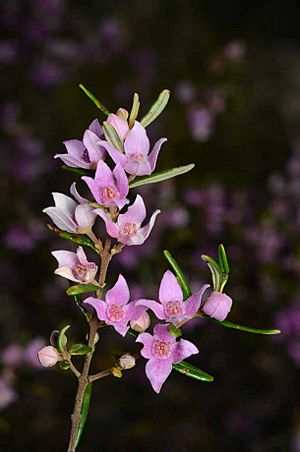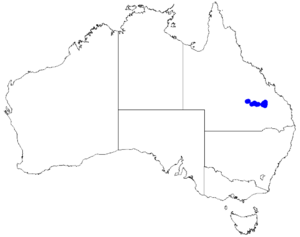Boronia forsteri facts for kids
Quick facts for kids Boronia forsteri |
|
|---|---|
 |
|
| Boronia forsteri in the Expedition National Park | |
| Scientific classification | |
 |
|
| Occurrence data from Australasian Virtual Herbarium |
Boronia forsteri is a plant that belongs to the citrus family called Rutaceae. It is found only in the mountain ranges of central Queensland, Australia. This plant is a tall, bushy shrub with many branches. Its leaves are simple, meaning they are not divided into smaller parts. The underside of the leaves is pale and very hairy. When it blooms, it has pretty pink flowers, each with four petals.
What it Looks Like
Boronia forsteri is a shrub that stands upright and has many branches. It can grow to about 1 meter (3 feet) tall. Its younger branches are covered with thick white or yellow hairs.
The leaves are shaped like an oval or an egg. They are usually 6 to 25 millimeters (0.2 to 1 inch) long and 0.5 to 5 millimeters (0.02 to 0.2 inches) wide. They don't have a small stalk connecting them to the stem. The bottom of the leaf is much lighter in color than the top and has many hairs.
The pink flowers usually grow one at a time, but sometimes up to three can appear together. Each flower sits on a short, hairy stalk, about 0.5 millimeters (0.02 inches) long.
Each flower has four sepals, which are like small leaves that protect the bud. These sepals are egg-shaped or triangular and very hairy. They are about 2 to 2.5 millimeters (0.08 to 0.1 inches) long. The four pink petals are 4 to 6 millimeters (0.16 to 0.24 inches) long. They get bigger as the plant starts to grow fruit. The flowers also have eight stamens, which are the parts that produce pollen, and these are also hairy.
This plant usually flowers in September and October. After flowering, it produces fruits that are about 5 to 6 millimeters (0.2 to 0.24 inches) long and 3 millimeters (0.12 inches) wide.
How it Got its Name
The plant Boronia forsteri was officially described in 1999 by a scientist named Marco F. Duretto. He published his description in a science journal called Austrobaileya. The plant was found near a place called "Glenhaugton."
The second part of its name, forsteri, was chosen to honor an Australian plant expert named Paul Irwin Forster.
Where it Lives
This type of boronia plant grows in woodlands and forests. It prefers areas with sandstone rocks. You can find it in the Chesterton, Carnarvon, and Expedition Ranges. It also grows in the Central Highlands area of Queensland.
Looking After the Plant
The Queensland Government has a law called the Nature Conservation Act 1992. Under this law, Boronia forsteri is listed as "least concern." This means that the plant is not currently in danger of disappearing. There are enough of these plants in the wild, so they don't need special protection right now.

